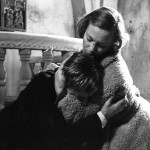Dir. by Ingmar Bergman
Images: Majority of dialogue is shot in tight close-ups, isolating characters from one another, as the small town and small church seem to also isolate them from the world. Discovery and removal of Jonas’ body is filmed in long shots: we see his body manipulated like lifeless flesh, exposed to the harsh elements of the snow storm. The bleak, cold exteriors reflects the inner state of the characters.
• • •
Critic Dave Kehr has written of Winter Light: “Routine stuff from Ingmar Bergman, the metaphysician of the middle class. . . . Much suffering, none of it very illuminating.” At the heart of Kehr’s criticism, it seems, is the assumption that for a work of art to be illuminating it must not only pose difficult questions, but provide universally satisfying answers as well. A crisis of faith, however, is a process, an on-going debate that can often seem frustratingly one-sided. Reducing such a debate to a simple question and an even simpler answer — as often happens both in the movies and the Church — only trivializes it. I’m relieved to find a film like Winter Light, which understands that at the very root of faith are those same unanswered (and perhaps unanswerable) questions. Despite its existential bleakness, watching Winter Light was, in fact, a faith-affirming experience for me.
Tomas (Gunnar Bjornstrand) is a pastor in a small town church. We see him, in the film’s opening scene, performing mass, an act that we later learn has become a loathsome ritual for him. With the death of his wife four years earlier, Tomas became cold, both to his congregation and to God. In what is perhaps the film’s most stunning image, we see him alone in his chambers, his face framed in a close-up and backlit by the sunlight pouring in through a window. In complete silence, he whispers Christ’s words, “My God, why hast thou forsaken me?” As Bergman tracks slowly forward, the fill light on Tomas’ face dims and the sunlight behind him brightens. This motif — darkened faces against brighter backgrounds — recurs throughout as a visual representation of the spiritual crisis being played out.
Also suffering are Marta (Ingrid Thulin) and Jonas (Max von Sydow). Marta is Tomas’ some time lover, a woman who was raised without the church, but who seems to have found something resembling faith in her selfless love for the pastor. She makes her love known to him in a letter that contains one of the most devastating lines any Christian could hear. “Most of all,” she tells Tomas, “I was struck by your extraordinary indifference to your Jesus Christ.” Jonas is a father and farmer who suffers anxiety over the constant threat of nuclear annihilation. When he visits Tomas for counsel, the pastor is of little help, able only to speak from his own personal disillusion.
What little change occurs in Tomas throughout the film, however, is not the result of Jonas’ suicide. He seems, finally, to be moved by the words of the church sexton, a crippled man of great faith, who talks to the pastor of Christ’s suffering — not the physical suffering of the cross, but the frustration and loneliness he must have felt when the disciples slept at Gethsemene, and the doubt and pain he must have suffered when God “forsook” him just before his death. Tomas appears to finally relate to Christ as a man who also felt God’s “silence.” I say “appears” because the film’s final image is appropriately ambiguous: Tomas returns to the empty sanctuary to perform another rite, perhaps changed by the events of the day, perhaps hopelessly resigned to simply playing his role.
